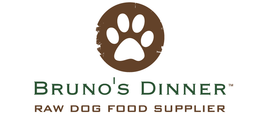Why Feed Raw?
The commercial dog food market became popular in the 1930's. For thousands of years dogs lived quite happily on a raw diet until humans decided to produce grain-based processed food in packaging for its convenience.
It is easy to feel confused when it comes to raw feeding. You need to consider your dog's weight, energy levels and correct balance of different food to ensure he gets adequate nutrition.
Here's what you need to know...
- Raw food is cheaper to buy than a commercial dog food diet.
- Your dog will delight in every meal. If you have a fussy dog or a dog who leaves their dinner then this will become a thing of the past.
- A dog’s digestive system is designed to eat raw food.
- Dogs produce significantly less faecal output (smaller poos) with a raw food diet because their digestive system digests and absorbs the food more efficiently.
- Dogs on a raw food diet usually have good teeth, a healthier shiny coat and a healthier weight.
- It is easier to control your dog’s weight; since you can weigh every meal and the quantity can be amended depending on your dog’s overall health.
Guidelines for Feeding You Dog
The general rule is to feed your dog 2-3% of its body weight per day. It is therefore important to weigh your dog to find out their weight. If your dog is overweight or underweight then you should be feeding them a percentage of their recommended weight. Your vet can advise you what to aim for.
In terms of what to feed - a general guideline is usually:
- 80% meat, fat, ligaments (tripe or mince for example)
- 10% edible bone (chicken wings, carcass, necks)
- 5 - 10% offal (liver, heart etc)
However, remember these are only guidelines – and it depends on your own dog’s preferences.
When feeding bone, it is best to ensure that the size of the bone is suitable for the dog. For example, it is better to feed a large dog a chicken thigh than a chicken wing, this way they need to chew it. However, once your dog does the transition then you can relax this rule.
Did you know that the benefits of chewing are widely known as relaxing? Endorphins are released when dogs chew, and these travel around the body, counteracting stress hormones.
It is recommended that your dog should have 2% - 3% of its body weight per day. All dogs are different so a very active dog may well need more. Only you know your dog so a little tweaking here and there at the start is par for the course, and will result in a daily consumption just right for your dog. We also sell scales to enable you to weigh every meal
Activity level
|
|
LOW |
LOW - MED |
MED - HIGH |
HIGH |
|
|
2% |
2.50% |
3% |
3.50% |
|
5kg |
100g |
125g |
150g |
175g |
|
10kg |
200g |
250g |
300g |
350g |
|
15kg |
300g |
375g |
450g |
525g |
|
20kg |
400g |
500g |
600g |
700g |
|
25kg |
500g |
625g |
750g |
875g |
|
30kg |
600g |
750g |
900g |
1050g |
|
35kg |
700g |
875g |
1050g |
1225g |
|
40kg |
800g |
1000g |
1200g |
1400g |
|
45kg |
900g |
1125g |
1350g |
1575g |
|
50kg |
1000g |
1250g |
1500g |
1750g |

